INDIAN OCEAN TRAVEL by TOURISMER
INDIAN OCEAN TRAVEL by TOURISMER

Responsible travel Malaysia
Malaysia occupies part of the Malay Peninsula and the island of Borneo. It is renowned for its beaches, tropical forests and Malay, Chinese, Indian and European cultural influences. Kuala Lumpur, the capital, is home to colonial buildings, shopping districts such as Bukit Bintang and skyscrapers like the iconic 451-metre-high Petronas twin towers.
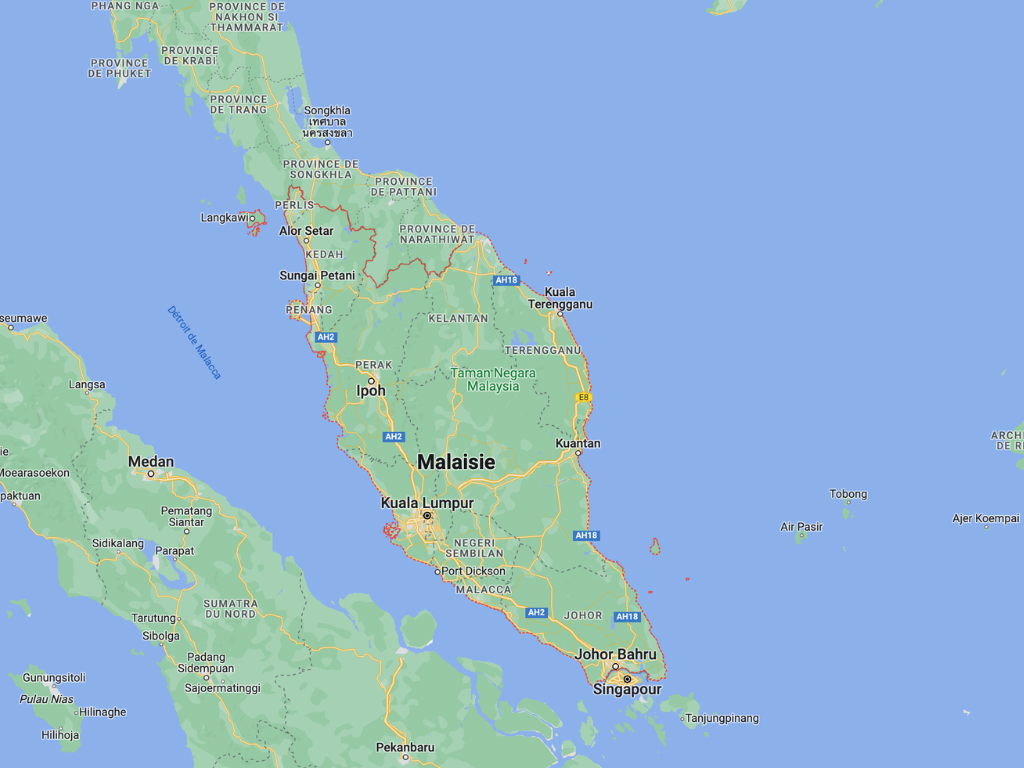
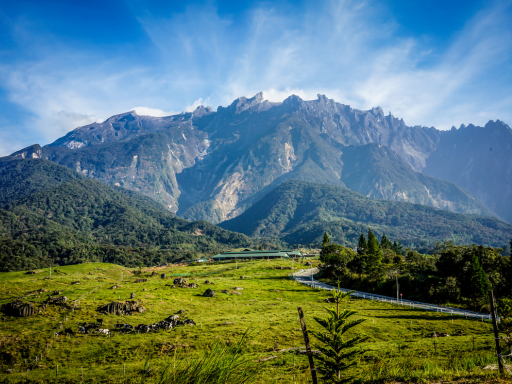
For now, these are local measures or taken by local operators, by hotels that have obtained certification with Earthcheck. In Borneo, eco-tourism is very present with in particular an incentive program in Surawa where volunteering is offered to help the locals, as in Saba, in Sarawa, where there are still tribal populations. Accommodation in eco-responsible lodges are offered in the primary forest and homestays to discover the lifestyle of people in immersion.
We are supporting

À l’origine, la Malaisie était une péninsule inhabitée, recouverte par une forêt vieille de 130 millions d’années ayant échappé à toutes les glaciations. Ce n’est que vers 10 000 avant J.-C. qu’arrivèrent les premiers aborigènes.
L’année 1511 marque la première présence européenne en Malaisie avec la prise de la ville de Malacca par le vice-roi portugais des Indes, Afonso de Albuquerque.
La prise de Malacca par les Portugais a pour conséquence : la rupture du réseau des marchands de l’Asie du Sud-Est insulaire et péninsulaire, et la christianisation de l’est de l’archipel indonésien.
En 1641, les Hollandais de la VOC « Compagnie hollandaise des Indes orientales », prennent à leur tour Malacca aux Portugais.
En 1795, les Britanniques s’emparent du territoire malais, avec l’île de Singapour.
En 1815, à la suite du traité de Vienne, Singapour, et tous les territoires malais au nord de Singapour, deviennent britanniques. Le Sabah, et Sarawak, au nord de Bornéo, deviennent britanniques. Les Hollandais reprennent les territoires au sud de Singapour, en 1817, ce qui constitue plus tard l’actuelle Indonésie.
La Malaisie est envahie et occupée par le Japon pendant la Seconde Guerre mondiale. Les troupes de l’armée impériale japonaise se livrèrent à un très grand nombre d’exactions, faisant en particulier des dizaines de milliers de morts parmi la minorité chinoise.
En 1948, le Parti communiste malais, qui avait représenté le fer de lance de la résistance à l’occupation japonaise, se préparait à mener une guerre de libération contre l’occupation britannique. L’insurrection est toutefois matée après plusieurs années de sévère répression (les soldats coloniaux coupèrent les mains, voire la tête, des rebelles capturés, et déplacèrent un demi-million de personnes dans des camps de concentration). Dans le même temps, Londres promet l’indépendance à des dirigeants jugés modérés, qui élargissent leur base en jouant sur la défiance raciale à l’égard de la minorité chinoise.
La Malaisie actuelle résulte de l’entrée en 1963 des territoires britanniques de Bornéo devenus indépendants, Sabah et Sarawak, dans la fédération de Malaisie, elle-même devenue indépendante en 1957.
Le retrait de Singapour de la fédération de Malaisie, le 9 août 1965 fut vu comme une partition de la Malaisie en deux états, avec la création de l’état de Singapour, majoritairement peuplé de Chinois, et la Malaisie, majoritairement peuplée de Malais musulmans, mais avec une forte minorité de Chinois.

Mahathir Mohamad est à l’origine de plusieurs projets économiques, dont les tours jumelles de Petronas, les tours jumelles les plus grandes au monde (452 m, 200 ascenseurs), qui sont devenus les symboles de la Malaisie moderne.
Fortement frappée en 1997 par la crise monétaire, la Malaisie choisit d’adopter une politique protectionniste. L’économie malaisienne se relève beaucoup plus rapidement que les économies indonésiennes ou thaïlandaises, avec une croissance de 5,4 % en 1999 et de 8 % en 2000.
La principale langue utilisée en Malaisie est le malaisien, qui est la seule ayant statut de langue officielle.e les langues les plus utilisées sont le malaisien (45%), le cantonais(5%), le mandarin (4%), le tamoul(14%) et l’anglais parlé à 30%.
La religion d’État est l’islam du courant sunnite et de l’école chaféite, observé principalement par la majorité malaise (61,3 % de la population).
Le bouddhisme est pratiqué par 19,8 % de la population, principalement au sein de la communauté chinoise, alors que 9,2 % de la population est chrétienne et 6,3 % est hindoue.
Literature
La littérature malaise classique comprend deux courants : un courant populaire et un courant plus élaboré qui s’est développé dans les cours des sultanats. Les genres littéraires sont variés. Parmi les genres en prose, on trouve le hikayat (épopée), le cerita (récit), le sejarah (histoire) ou silsilah (généalogie) et le undang-undang (recueil de coutumes).
Les pratiques culturelles des peuples aborigènes de la péninsule, du Sarawak et du Sabah sont façonnées en grande partie par la tradition orale. Au Sarawak, des thèmes comme les relations entre individus d’une même tribu (et plus particulièrement avec les ancêtres et le monde des esprits) et leur influence sur la santé et la quête de nourriture, sont les thèmes majeurs de la littérature orale des ethnies aborigènes locales.
Les armes
Depuis l’Antiquité jusqu’au XIXe siècle, les routes maritimes qui favorisent les échanges d’épices, de pierres précieuses et de soie se multiplient.Les armes orientales rapportées de ces contrées lointaines sont des trophées voici le kriss Dapor Bener, d’origine malaisienne.
Source: https://mai.saint-etienne.fr/decouvrir/musee/parcours-de-visites/parcours-armes/kriss-malais
Weaving
Le songket est un tissu traditionnel malaisien tissé à la main par les femmes de la péninsule malaise et Sarawak. Le terme songket provient d’une technique de tissage ornemental, consistant à insérer un fil d’or ou d’argent entre les fils de trame et les fils de chaîne. Les tissus couramment utilisés dans la fabrication de Songket comprennent la soie, le coton et le coton de soie.
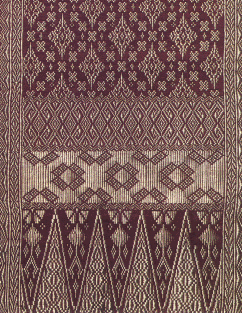
Poteries
Elles peuvent etre : le labu sayong,des poteries utilisées pour stocker l’eau.
The belanga, un pot rond à large bord qui sert à cuire les currys.

The terenang ceramic, une poterie utilisée pour stocker l’eau dans les temps anciens. il était traditionnellement fabriqué en utilisant une méthode qui prenait beaucoup de temps, qui est la méthode « pincer et presser ».
Sculptures Sur bois
Les sculptures sur bois des Orang Asli « peuple aborigène » en malais) sont une population autochtone hétérogène formant une minorité nationale en Malaisie. Ce sont les plus anciens habitants de la péninsule malaise.)
The cuisine malaisienne est issue de la fusion d’influences locales, indiennes, javanaises et chinoises pour l’essentiel, mais auxquelles s’ajoutent des influences de groupes ethniques locaux de Sabah et Sarawak, des Orang Asli comme des Peranakan. Sans oublier l’apport des migrations antérieures, puis coloniales , qui amènent à la cuisine malaise des touches britanniques, portugaises, hollandaises ou thaïes.
Some emblematic dishes:
Le poulet satay malaisien
Il est principalement servi sous forme de brochettes. Le satay est une sauce à base de cacahuètes, d’ail et de sauce soja.

Le Mee Rebus
C’est un plat de nouilles aux œufs accompagnées de patate douce, des graines de soja, de crevettes et de cacahuètes, dans une sauce à base de curry.
Le Putu Bambu
Un succulent dessert!
C’est une bouchée préparée dans un tube de bambou et à base de sucre de palme et d’une farine de riz avec un colorant de feuille de pandan vert , de tapioca. Il est cuit à la vapeur , sorti du tube de bambou puis roulé dans de la noix de coco râpée pour être prêt à être servi.

 George Town is the colorful multicultural capital of the Malaysian island of Penang. A former trading hub of the Straits of Malacca, the city is renowned for its British colonial buildings, Chinese shophouses and mosques. Beyond the Old Town, George Town is a modern city with skyscrapers and shopping malls. The verdant hill of Penang Hill, featuring hiking trails and a cable car, overlooks the city.
George Town is the colorful multicultural capital of the Malaysian island of Penang. A former trading hub of the Straits of Malacca, the city is renowned for its British colonial buildings, Chinese shophouses and mosques. Beyond the Old Town, George Town is a modern city with skyscrapers and shopping malls. The verdant hill of Penang Hill, featuring hiking trails and a cable car, overlooks the city.
 Malacca (or Bandar Melaka) is the capital of the coastal state of Malacca located in southwestern Malaysia. In the center, Jonker Walk, the main artery of Chinatown, is known for its antique shops and its night market. Nearby, the Chinese temple Cheng Hoon Teng, richly decorated and with many prayer rooms, dates from the 17th century. The Kampung Kling Mosque, dating from the 18th century, features a Javanese style and has a three-tiered green roof.
Malacca (or Bandar Melaka) is the capital of the coastal state of Malacca located in southwestern Malaysia. In the center, Jonker Walk, the main artery of Chinatown, is known for its antique shops and its night market. Nearby, the Chinese temple Cheng Hoon Teng, richly decorated and with many prayer rooms, dates from the 17th century. The Kampung Kling Mosque, dating from the 18th century, features a Javanese style and has a three-tiered green roof.
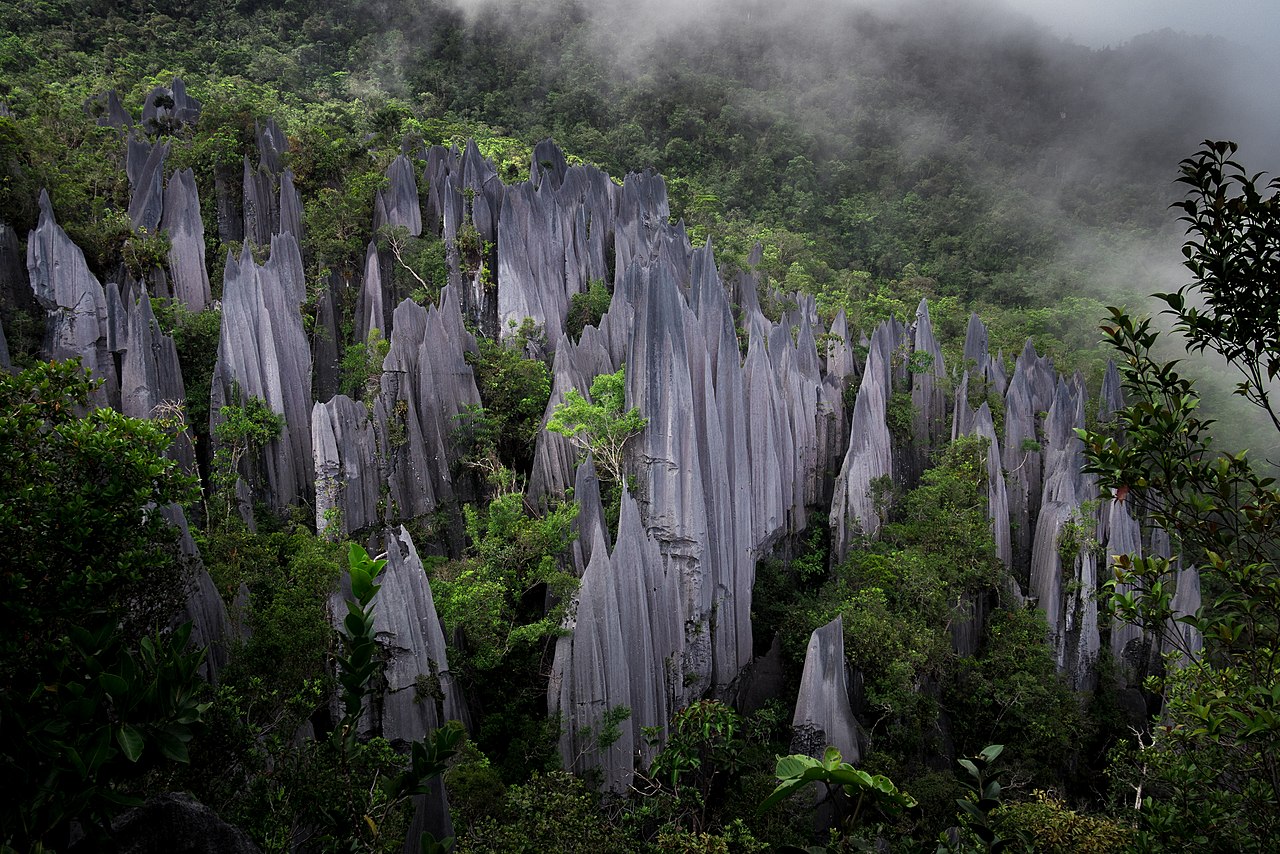
Gunung Mulu National Park (52,864 ha), in the state of Sarawak on the island of Borneo, is the most studied tropical karst region in the world. The park contains 17 vegetation zones with approximately 3,500 species of vascular plants. It is considered one of the richest sites in the world for palms, with 109 species of 20 genera described. The summit of Gunung Mulu, a 2,377m high karst peak, dominates the park. At least 295 km of explored caves offer an extraordinary spectacle with millions of swiftlets and bats. The Sarawak Hall, measuring 600 m by 415 m and 80 m high, is the largest known underground hall in the world.
 This park, located in the state of Sabah, in the north of the island of Borneo, is dominated by Mount Kinabalu (4,095 m), the highest mountain between the Himalayas and New Guinea. It has a wide range of habitats: rich lowland and hillside tropical rainforests, montane rainforest, and, higher in elevation, subalpine forests and evergreen shrublands. Kinabalu Park has been designated as the Center of Plant Diversity for the Southeast Asian region. It is exceptionally species-rich, exhibiting elements of the Himalayan, Chinese, Australian, Malay and Pantropical floras.
This park, located in the state of Sabah, in the north of the island of Borneo, is dominated by Mount Kinabalu (4,095 m), the highest mountain between the Himalayas and New Guinea. It has a wide range of habitats: rich lowland and hillside tropical rainforests, montane rainforest, and, higher in elevation, subalpine forests and evergreen shrublands. Kinabalu Park has been designated as the Center of Plant Diversity for the Southeast Asian region. It is exceptionally species-rich, exhibiting elements of the Himalayan, Chinese, Australian, Malay and Pantropical floras.
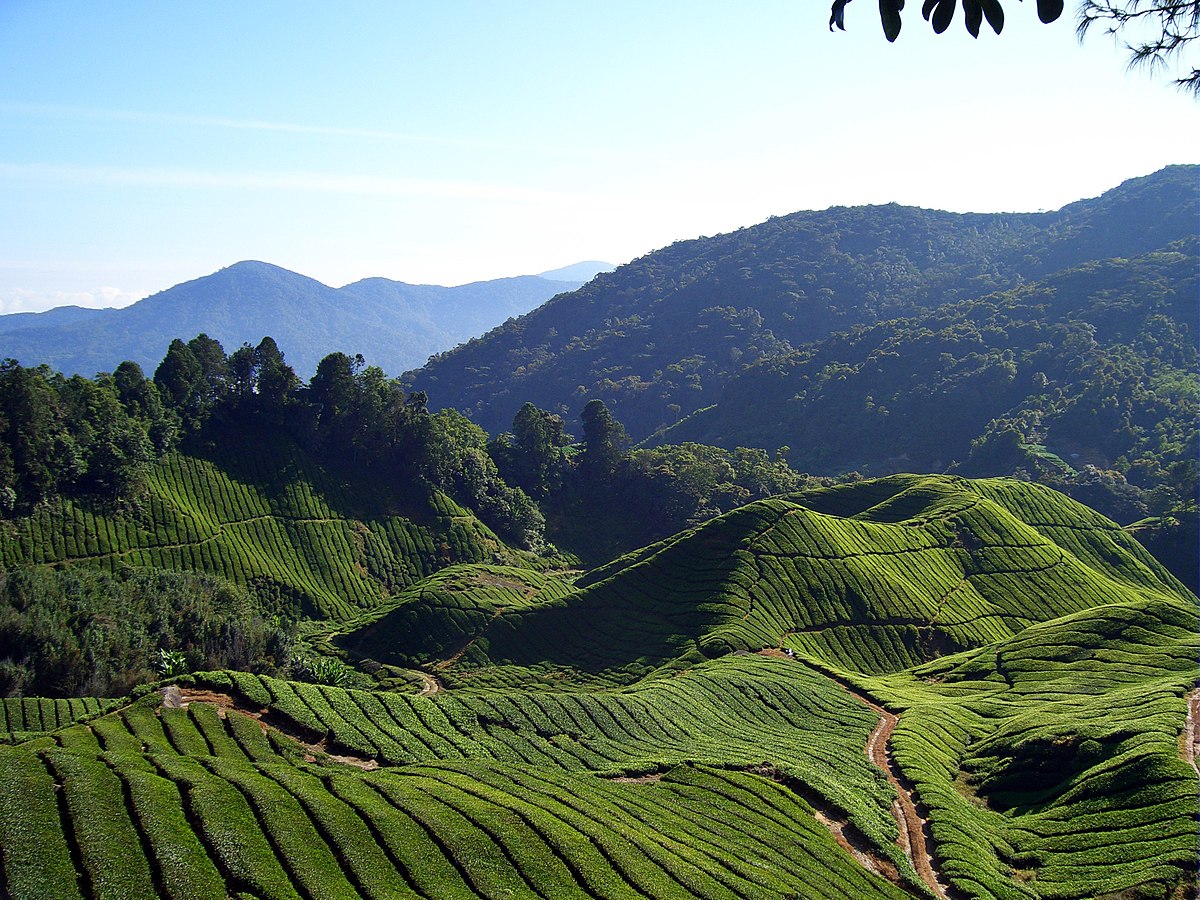 Explored by the British William Cameron (explorer) in 1885, the Cameron Highlands became a mountain resort in the 1930s. Many tea plantations were also developed. The region has become an important tourist site.
Explored by the British William Cameron (explorer) in 1885, the Cameron Highlands became a mountain resort in the 1930s. Many tea plantations were also developed. The region has become an important tourist site.
 The name perhentian means "stopping point" in Malay, and the islands have long been a stopover for traders sailing between Bangkok and Malaysia. The islands have been inhabited by fishermen for centuries, but today it is tourism that represents the bulk of economic activity.
The name perhentian means "stopping point" in Malay, and the islands have long been a stopover for traders sailing between Bangkok and Malaysia. The islands have been inhabited by fishermen for centuries, but today it is tourism that represents the bulk of economic activity.
The two main islands are lined with white sand beaches. The reefs and crystal clear waters are home to a wide variety of corals, sea turtles, jellyfish, reef sharks and small fish. The maximum altitude of the islands is around 100 m, and they are evenly covered in coastal rainforest, with some tracks and trails going inland. There are no roads on both islands and the only means of transport are walking and water taxi.
 The Malaysia National Park is the oldest and largest national nature park located in Peninsular Malaysia. This national park contains what scientists consider to be one of the oldest tropical forests in the world. It is estimated that it has existed for 130 million years. This large protected area is home to a rich and complex ecosystem. Many activities are offered to tourists to discover the park. Thus, marked paths are laid out inside the forest to observe the natural environment. It is even possible to take a suspension bridge at canopy level to admire the forest from above. It's about largest suspension bridge in the world.
The Malaysia National Park is the oldest and largest national nature park located in Peninsular Malaysia. This national park contains what scientists consider to be one of the oldest tropical forests in the world. It is estimated that it has existed for 130 million years. This large protected area is home to a rich and complex ecosystem. Many activities are offered to tourists to discover the park. Thus, marked paths are laid out inside the forest to observe the natural environment. It is even possible to take a suspension bridge at canopy level to admire the forest from above. It's about largest suspension bridge in the world.
 The Sarawak Cultural Village sits at the foot of Mount Santubong. Surrounded by rainforest, this living museum offers visitors insight into the culture and traditions of Sarawak's 7 major ethnic groups. Here you get a sense of what life in Sarawak was like through replicas of longhouses and other traditional dwellings, as well as demonstrations of daily activities at that time such as forging machetes, preparing typical snacks or use a blowgun. A cultural show that brings you closer to traditional music, songs and dances of different ethnic groups. Be enchanted by the colorful clothes, the rhythmic movements and sometimes even the acrobatic performances of the local dancers!
The Sarawak Cultural Village sits at the foot of Mount Santubong. Surrounded by rainforest, this living museum offers visitors insight into the culture and traditions of Sarawak's 7 major ethnic groups. Here you get a sense of what life in Sarawak was like through replicas of longhouses and other traditional dwellings, as well as demonstrations of daily activities at that time such as forging machetes, preparing typical snacks or use a blowgun. A cultural show that brings you closer to traditional music, songs and dances of different ethnic groups. Be enchanted by the colorful clothes, the rhythmic movements and sometimes even the acrobatic performances of the local dancers!
 A global city, Kuala Lumpur has seen the development of many skyscrapers in its business district, including the Petronas Towers, which were the tallest in the world. Its industrial development has been made in particular around new technologies and finance.
A global city, Kuala Lumpur has seen the development of many skyscrapers in its business district, including the Petronas Towers, which were the tallest in the world. Its industrial development has been made in particular around new technologies and finance.
Its name, meaning "muddy confluence", is explained by its location at the confluence of two rivers: the Kelang River, the largest, and one of its tributaries, the Gombak. Its climate is equatorial, with average temperatures and very high rainfall all year round. A cosmopolitan city, Kuala Lumpur has the particularity of being populated by 43% Chinese, almost as many as Malays (45%); it thus constitutes a sort of Buddhist enclave in a predominantly Muslim country. The city also has monuments dating from the British colonial era, such as the Kuala Lumpur train station and the Sultan Abdul Samad building.
 The Mount Kinabalu, is a mountain in Malaysia, the highest point of this country and the island of Borneo with 4,095 meters above sea level. Its great biodiversity is made possible by a unique geology and climate. It includes many endemic species, including several carnivorous plants as well as many orchids, protected by Kinabalu National Park. This wealth was discovered by Hugh Low and John Whitehead in the middle of the XIXe century, the latter being the author of the first ascent of the main peak in 1888. It is one of the most visited mountains in Southeast Asia.
The Mount Kinabalu, is a mountain in Malaysia, the highest point of this country and the island of Borneo with 4,095 meters above sea level. Its great biodiversity is made possible by a unique geology and climate. It includes many endemic species, including several carnivorous plants as well as many orchids, protected by Kinabalu National Park. This wealth was discovered by Hugh Low and John Whitehead in the middle of the XIXe century, the latter being the author of the first ascent of the main peak in 1888. It is one of the most visited mountains in Southeast Asia.
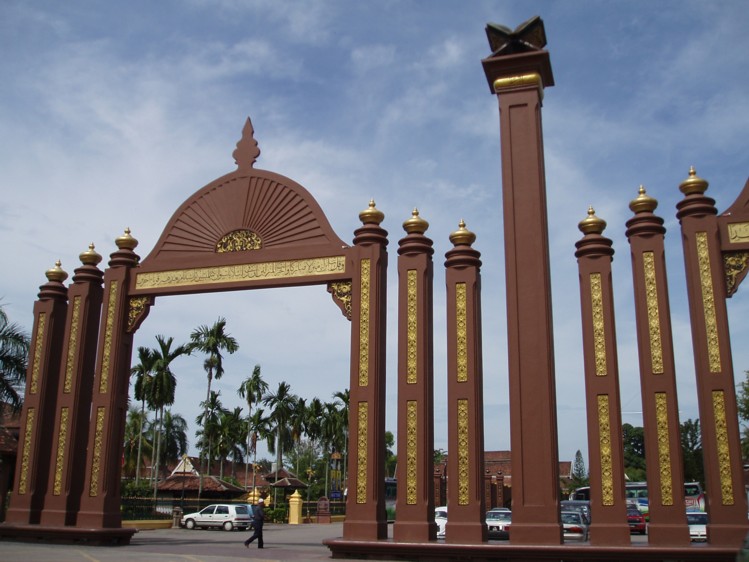
Kota Bharu is a city in Malaysia founded in 1844 by Sultan Muhammad II of Kelantan. It has been the state capital of Kelantan since 1844, of which it is also the largest city. Its name means "new city" or "new fort" in Malay. If you want to immerse yourself in the culture of the country, you can admire the craftsmen making kites, puppets, batiks, go to the cultural center and enjoy the dances, the game of bowls... In the War Memorial Museum you will find photos and documents related to the Second World War and also a very nice collection of Japanese swords.
 The Batu Caves are a set of caves, some of which have been converted into temples, in a limestone hill located 10 kilometers north of Kuala Lumpur.
The Batu Caves are a set of caves, some of which have been converted into temples, in a limestone hill located 10 kilometers north of Kuala Lumpur.
These caves are the largest Hindu shrine outside India. Consecrated to Murugan (Kârttikeya), these sanctuaries are among the most popular outside India. It is the gathering point during the great Hindu festival of Thaipusam in Malaysia. There are many animals in this cave, such as monkeys, chickens, roosters, etc.
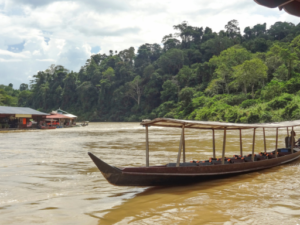 This park was established in 1938-1939 as King George V National Park, after Theodore Hubback pressured the Sultans of Pahang, Terengganu and Kelantan to set aside a tract of land covering the three States with a view to creating a protected area. It was renamed Taman Negara after independence, which means "national park" in Malay. With a total area of 4,343 km2, Taman Negara is one of the oldest deciduous rainforests in the world, estimated to be over 130 million years old.
This park was established in 1938-1939 as King George V National Park, after Theodore Hubback pressured the Sultans of Pahang, Terengganu and Kelantan to set aside a tract of land covering the three States with a view to creating a protected area. It was renamed Taman Negara after independence, which means "national park" in Malay. With a total area of 4,343 km2, Taman Negara is one of the oldest deciduous rainforests in the world, estimated to be over 130 million years old.
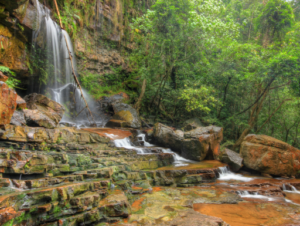 It is a protected rainforest located in a massif on the southern foothills of the Tenasserim Hills, straddling the Segamat and Mersing districts in northeast Johor and the Rompin district in southern Pahang. It covers a total area of approximately 870 km2, making it the second largest national park in Peninsular Malaysia after Taman Negara. It has about 26 km of trails. It is the second national park proclaimed by the government of Malaysia. Gunung Besar, the second highest peak in Johor, lies within the park.
It is a protected rainforest located in a massif on the southern foothills of the Tenasserim Hills, straddling the Segamat and Mersing districts in northeast Johor and the Rompin district in southern Pahang. It covers a total area of approximately 870 km2, making it the second largest national park in Peninsular Malaysia after Taman Negara. It has about 26 km of trails. It is the second national park proclaimed by the government of Malaysia. Gunung Besar, the second highest peak in Johor, lies within the park.
The park takes its name from the Endau and Rompin rivers that cross it. The other rivers that cross the park are the Segamat, the Selai and the Jasin.
There are two official entry points to the park: Kampung Peta Entrance, located along the eastern border in Mersing District, and Selai Entrance, located on the southwestern border in Segamat District.
During the monsoon, from November to March, the park is closed to the public. Fishing is prohibited from September to October during the mating season.
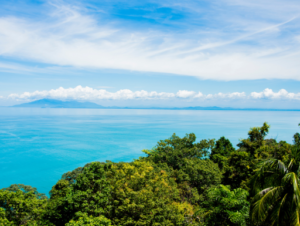 This park covers 1,213 hectares of land and sea and is used by scientists, researchers and nature lovers to explore its natural treasures.
This park covers 1,213 hectares of land and sea and is used by scientists, researchers and nature lovers to explore its natural treasures.
Formerly known as Pantai Acheh Forest Reserve, this pristine site is home to 417 species of flora and 143 species of fauna. Pantai Acheh Forest Reserve, located on the northwest tip of Penang Island, was declared a Penang National Park in April 2003.
Penang National Park is the first legally declared protected area under the Malaysian National Parks Act of 1980, which is a testament to state and federal efforts in environmental protection.
Penang National Park was established to preserve and protect flora and fauna as well as objects of geological, archaeological, historical, ethnological, scientific and scenic interest.
The natural attractions of Pulau Pinang National Park include hill and lowland dipterocarp forests, areas of mangrove forests, sandy beach habitats, a seasonal meromictic lake, and open coastal seas. Stands of seraya trees (Shorea curtisii), a common feature of coastal dipterocarp forests, can be easily seen on the steep slopes around Muka Head. More than 1,000 species of plants have been recorded and are dominated by the families Dipterocarpaceae, Leguminosae, Apocynaceae, Anacardiaceae, Euphorbiaceae and Moraceae.
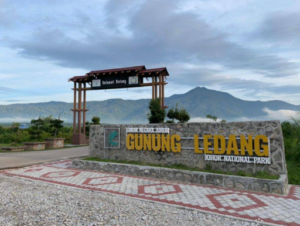 Mount Ledang National Park is a national park located in Tangkak District. It is home to the peak of Mount Ledang, which rises to 1,276 meters, and was established in 2005. It is now one of the most famous hiking destinations in Johor.
Mount Ledang National Park is a national park located in Tangkak District. It is home to the peak of Mount Ledang, which rises to 1,276 meters, and was established in 2005. It is now one of the most famous hiking destinations in Johor.
Mount Ledang is also steeped in legends. Many legends center on the mythical princess Puteri Gunung Ledang.
About 160 species of birds have been recorded in the park.
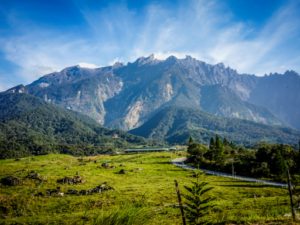 On the island of Borneo, there are excellent courses for hiking trekking right in the middle of the jungle. By way of illustration, in Sabah, it is advisable to visit the Kinabalu National Park. This park is home to many endemic species of insects and amphibians, more than 326 species of birds and a hundred species of mammals (orangutan, Malayan weasel, gray otter, etc.).
On the island of Borneo, there are excellent courses for hiking trekking right in the middle of the jungle. By way of illustration, in Sabah, it is advisable to visit the Kinabalu National Park. This park is home to many endemic species of insects and amphibians, more than 326 species of birds and a hundred species of mammals (orangutan, Malayan weasel, gray otter, etc.).
You can climb Mount Kinabalu which rises to 4095m.
The presence of a guide is mandatory, it is not possible to walk in the park without a guide, let alone attempt the ascent. The ascent is done in 2 days: from the Tipohon Gate to the refuge, overnight at the refuge, then the summit and the descent in the same day.
You have to book your ascent several weeks in advance because it is one of the most climbed peaks in South East Asia, around 200€ per person: entrance to the park, the guide, one night in a refuge (at 3,200m ). During the course you will see lush vegetation composed, among other things, of orchids, eucalyptus and carnivorous plants. On the Sarawak side, the Gunung Mulu National Park offers an impressive network of underground cavities that can be visited.
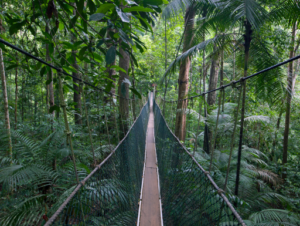 Located on Peninsular Malaysia, it is one of the best places to snorkel. trekking. You explore one of the oldest tropical forests in the world. Its age is estimated at more than 130 million years.
Located on Peninsular Malaysia, it is one of the best places to snorkel. trekking. You explore one of the oldest tropical forests in the world. Its age is estimated at more than 130 million years.
It is possible to do different programs here, from short ones to several days. From excursions guided tours, it is advisable to go to the Bukit Teresek observation center, located at 334 m. A panoramic view of a surprising landscape awaits you.
The Canopy Walkway, offers you a 500 m long suspension bridge at a height of 40 m. Along the way, you can admire an admirable biodiversity: 10,000 species of plants, 350 species of birds, more than 200 kinds of mammals, more than 60 kinds of reptiles, more than a hundred species of fish!
For train transport, 5 classes are offered to the public: Economy – bench seats, Business – individual seats, Executive – individual and reclining seats, Priority – exclusive and reclining seats and Luxe – sleeper seats. Some trains are equipped and have custom facilities, with variable passenger capacity, interior layout and themed decoration. These trains called Kereta Wisata or “tourist trains” are the Kereta Nusantara, Kereta Sumatera, Kereta Jawa, Kereta Bali, Kereta Toraja, Kereta Priority and Kereta Imperial.
The jungle train is one of the most magnificent journeys in Southeast Asia. The journey is approximately 526 km. The train goes through several rivers and mountains.
Le train est officiellement connu sous le nom de East Coast Railway Line.
The Jungle Train connects the city of Johor Bahru in the south to Tumpat on the East coast.
As for his nickname "jungle train", it comes from the fact that the train goes through the tropical jungle. Do not travel at night, so as not to miss this spectacle.
Malaysia is full of large forests that are home to oil palm plantations.
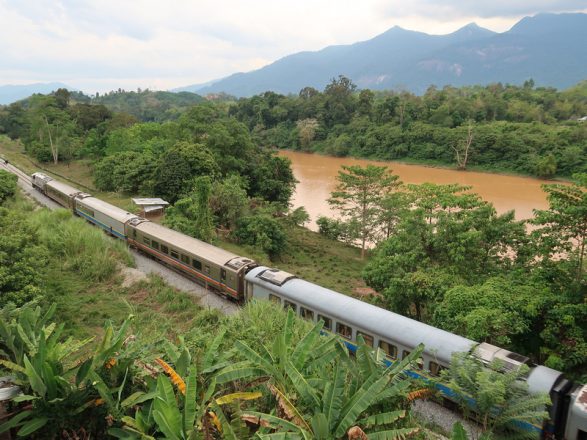
The price of daily rental ranges from 30 to 40 €, and the advantage is that gasoline is not expensive, you fill up with 20 €. If you are a family of 4 or 5, it is also most certainly the most cost-effective way to get around.
Please note, driving on the left, international driving license required.
It is relatively easy to rent a motorbike/scooter, and cheap (10€ per day). You must have an international license (like for renting a car). Be careful to be well insured, traffic is very heavy in the city.
The bus network is dense and works well. It serves all the major cities of the peninsula, at a fairly high frequency. You can opt for night buses over long distances. They are comfortable and air-conditioned.Traveling by bus can be long, but it is inexpensive; and it is sometimes the only option to get to certain places.
There is 2 main lines : one that runs along the west coast of Thailand, passing through Penang, Ipoh, and KL. And the other which crosses the peninsula diagonally, from the North-East (Kota Bharu) to the South.
It is possible to travel by taxi on long distances, but it remains relatively expensive. If you want to use it, be aware that it is quite possible to negotiate the prices. The urban taxi are plentiful and inexpensive.
The speed – boat and ferry are the only ways to get to the islands.
Find more updated information on Tourism in Malaysia in our Blog Tourismer.io
 The Global Peace Foundation promotes an innovative, values-based approach to peacebuilding, guided by the vision that all human beings are members of one family.
The Global Peace Foundation promotes an innovative, values-based approach to peacebuilding, guided by the vision that all human beings are members of one family.
JCI Malaysia Sustainability Award 2022
We received this award for our projects around SDG 6 – Clean Water and Sanitation. Projects include access to drinking water, construction of toilets and WaSH training for Orang Asli villages.
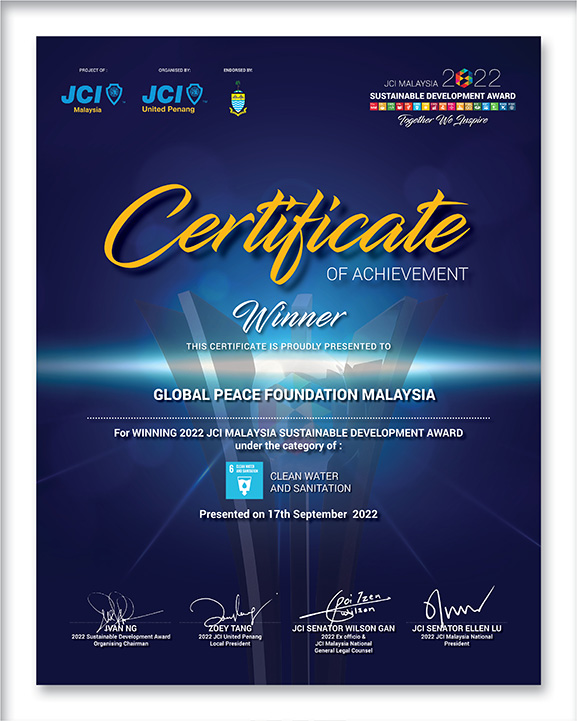
https://globalpeace.org.my/